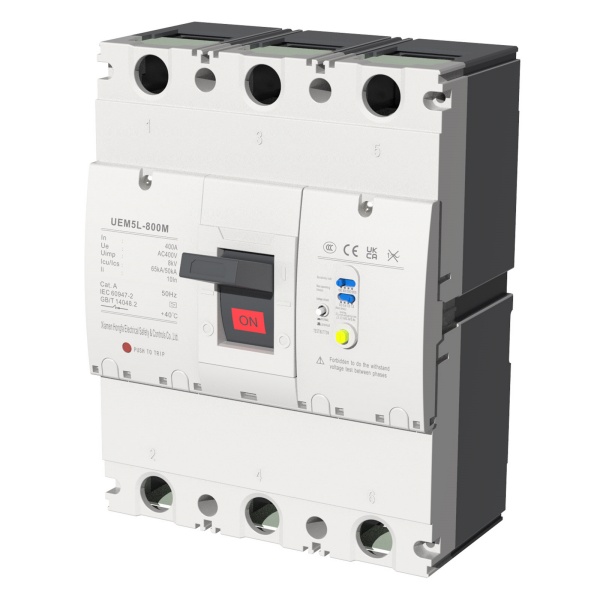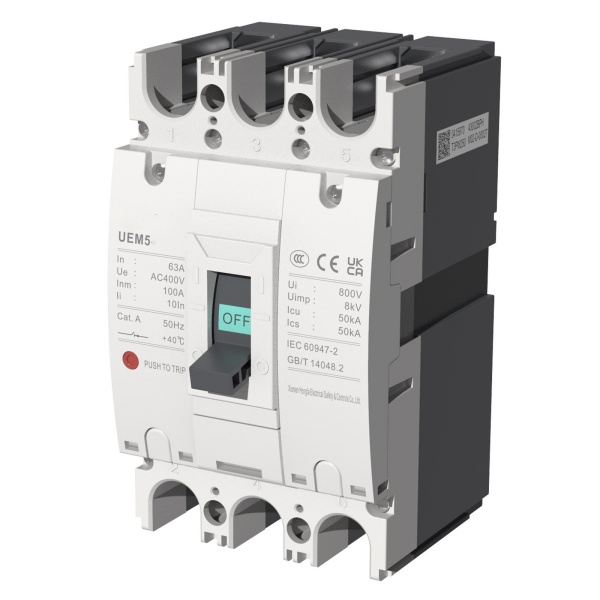In the field of electrical safety, miniature circuit breakers (MCBs) and molded case circuit breakers (MCCBs) are two basic but crucial protection devices. They are each designed to meet different application requirements and safety standards. The following is a further explanation of their safety performance differences:

UEM5L MCCB RCD Circuit Breaker
1. Current breaking capacity and selectivity
Molded case circuit breakers are designed to carry and break higher levels of current. They are usually used for main distribution and high-power equipment protection, with higher short-circuit breaking capacity (Ics) and rated ultimate short-circuit breaking capacity (Icu).
Miniature circuit breakers focus more on providing fine current protection and are suitable for branch circuits in homes and commercial buildings. They have better selective protection, which can ensure that in the event of overload or short circuit, only the circuit breaker closest to the fault point is activated.
2. Adaptability of protection characteristics
The C curve and D curve of the miniature circuit breaker are respectively suitable for different load types, such as C curve for conventional loads and D curve for motor loads with higher starting currents.
Molded case circuit breakers usually do not emphasize curve classification, but they can be used with thermal relays or electronic protection devices to provide more accurate overload protection for equipment such as motors.
3. Structural differences and operational safety
Molded case circuit breakers are larger in size and more rugged in structure, and can adapt to more stringent industrial environments and operating conditions, but they also require more operating space.
The compact design of miniature circuit breakers makes them easy to install and operate, suitable for space-constrained occasions, but additional marking or protective measures may be required to avoid misoperation.
4. Environmental tolerance
Molded case circuit breakers usually have stronger environmental tolerance and can resist dust, moisture and other adverse factors in industrial environments.
Although miniature circuit breakers are also designed to have certain environmental adaptability, they are more used in indoor environments and have relatively stricter requirements on environmental conditions.
5. Maintenance and testing
Due to their high load characteristics, molded case circuit breakers may require more frequent professional maintenance and testing to ensure that they can reliably interrupt fault currents at critical moments.
Maintenance of miniature circuit breakers is relatively simple, but regular inspection and testing are still necessary, especially for those circuit breakers that bear critical loads.
6. Cost and Benefit
Molded case circuit breakers are generally more expensive due to their high specifications and complexity, but the high safety performance and reliability they provide are essential for large electrical systems.
Miniature circuit breakers are low-cost and suitable for a large number of applications. Their affordability and ease of use make them a standard choice in residential and commercial buildings.
7. Intelligence and Future Development
With the development of technology, modern miniature circuit breakers and molded case circuit breakers have begun to integrate intelligent components, such as communication interfaces and monitoring functions, which not only improves their safety performance, but also enables them to better integrate into smart grids and automation systems.

UEM5 AC MCCB Circuit Breaker
By deeply understanding the differences in safety performance between miniature circuit breakers and molded case circuit breakers, electrical engineers can more accurately select appropriate protection devices for various application scenarios to ensure the safety, reliability and economy of electrical systems. Further, miniature circuit breakers and molded case circuit breakers play an indispensable role in modern electrical systems. They not only ensure the stable operation of power systems, but also improve energy efficiency management and fault response speed. With the continuous advancement of intelligent technology, future circuit breakers will integrate more advanced functions, such as remote monitoring, fault prediction and self-diagnosis capabilities, thus bringing revolutionary changes to the field of electrical safety. This technological integration indicates that electrical protection equipment will be more intelligent, flexible and user-friendly, further promoting the modernization and sustainable development of power systems.
Post time: 7 月-22-2024


